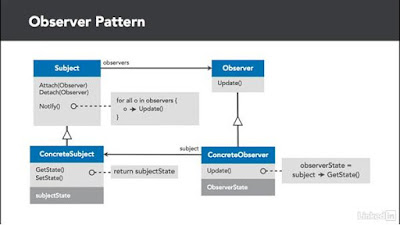A design pattern is a reusable solution for a commonly occurring problem. In the next three tables are the original design patterns as they are described in the book: "Design Patterns: Elements of Reusable Object-Oriented Software". They are divided into three groups:
- Creational
- Structural
- Behavioral
| Creational |
| Abstract Factory | Provide an interface for creating families of related or dependent objects without specifying their concrete classes. |
| Builder | Separate the construction of a complex object from its representation allowing the same construction process to create various representations. |
| Factory Method | Define an interface for creating an object, but let subclasses decide which class to instantiate. Factory Method lets a class defer instantiation to subclasses. |
| Lazy initialization | Tactic of delaying the creation of an object, the calculation of a value, or some other expensive process until the first time it is needed. This pattern appears in the GoF catalog as "virtual proxy", an implementation strategy for the Proxy pattern. |
| Prototype | Specify the kinds of objects to create using a prototypical instance, and create new objects by copying this prototype. |
| Singleton | Ensure a class has only one instance, and provide a global point of access to it. |
| Structural |
| Adapter | Convert the interface of a class into another interface clients expect. An adapter lets classes work together that could not otherwise because of incompatible interfaces. The enterprise integration pattern equivalent is the translator. |
| Bridge | Decouple an abstraction from its implementation allowing the two to vary independently. |
| Composite | Compose objects into tree structures to represent part-whole hierarchies. Composite lets clients treat individual objects and compositions of objects uniformly. |
| Decorator | Attach additional responsibilities to an object dynamically keeping the same interface. Decorators provide a flexible alternative to subclassing for extending functionality. |
| Facade | Provide a unified interface to a set of interfaces in a subsystem. Facade defines a higher-level interface that makes the subsystem easier to use. |
| Flyweight | Use sharing to support large numbers of similar objects efficiently. |
| Proxy | Provide a surrogate or placeholder for another object to control access to it. |
| Behavioral |
| Chain of responsibility | Avoid coupling the sender of a request to its receiver by giving more than one object a chance to handle the request. Chain the receiving objects and pass the request along with the chain until an object handles it. |
| Command | Encapsulate a request as an object, thereby letting you parameterize clients with different requests, queue or log requests, and support undoable operations. |
| Interpreter | Given a language, define a representation for its grammar along with an interpreter that uses the representation to interpret sentences in the language. |
| Iterator | Provide a way to access the elements of an aggregate object sequentially without exposing its underlying representation. |
| Mediator | Define an object that encapsulates how a set of objects interact. Mediator promotes loose coupling by keeping objects from referring to each other explicitly, and it lets you vary their interaction independently. |
| Memento | Without violating encapsulation, capture and externalize an object's internal state allowing the object to be restored to this state later. |
| Observer | Define a one-to-many dependency between objects where a state change in one object results in all its dependents being notified and updated automatically. |
| State | Allow an object to alter its behavior when its internal state changes. The object will appear to change its class. |
| Strategy | Defines a family of algorithms, encapsulates each one, and makes them interchangeable. Strategy lets the algorithm vary independently from clients that use it. |
| Template method | Define the skeleton of an algorithm in an operation, deferring some steps to subclasses. Template method lets subclasses redefine certain steps of an algorithm without changing the algorithm's structure. |
| Visitor | Represent an operation to be performed on the elements of an object structure. Visitor lets you define a new operation without changing the classes of the elements on which it operates. |

Comments
Post a Comment